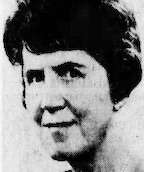Catherine Gavin
Catherine Irvine Gavin (1907 – 2000) was a Scottish academic historian, war correspondent, and historical novelist.[1]
Catherine Gavin | |
|---|---|
 Catherine Gavin, from a 1969 newspaper. | |
| Born | 1907 Aberdeen, Scotland |
| Died | 2000 (aged 92–93) |
| Nationality | Scottish |
| Occupation | historian, academic, war correspondent, novelist |
| Academic background | |
| Alma mater | University of Aberdeen |
| Academic work | |
| Institutions | University of Aberdeen University of Glasgow Kemsley Newspapers |
Early life
Gavin was born in Aberdeen in 1907,[2] and studied history and English at the University of Aberdeen, graduating with first-class honours.[1] She completed doctoral work in 1931, with a doctoral thesis on Louis Philippe of France; her thesis was published in 1933.[3]
Career
Gavin held positions as a history lecturer at Aberdeen and at the University of Glasgow.[1] She stood unsuccessfully as a Unionist candidate in two parliamentary elections in the 1930s.[1]
During World War II, she worked in France and the Netherlands for Kemsley Newspapers.[1] She also wrote a biography of Edward VII, published in 1941. She was a correspondent in the Middle East and Ethiopia after the war, for the Daily Express. After marriage, she worked a few years on the staff of Time magazine in New York.[2] She wrote about her wartime experiences in Liberated France (1955).[4]
Most of Gavin's literary output was in the genre of historical romance.[5] "Her characters are attractive flesh-and-blood people, her narrative adventurous and suspenseful, and her use of history skillful and unerring," reported one American reviewer in 1957.[6] The University of Aberdeen awarded her an honorary DLitt in 1986.[1] The Catherine Gavin Room there is named in her honour.[1] The university has a 1940 portrait of her, in oil, by Elizabeth Mary Watt.[7]
Gavin appeared as a "castaway" on the BBC Radio programme Desert Island Discs on 24 June 1978.[8]
Selected works
Gavin's works of historical fiction include the following titles:
- Clyde Valley (1938)[9]
- The Hostile Shore (1940)
- The Black Milestone (1941)[10]
- The Mountain of Light (1944)
- Madeleine (1957)[11]
- The Cactus and the Crown (1962)[12][13]
- The Fortress (1964)
- The Moon Into Blood (1966)
- The Devil in Harbour (1968)[5]
- The House of War (1970)[14]
- Give Me the Daggers (1972)[15][16]
- The Snow Mountain (1973)[17]
- Traitors' Gate (1976)
- None Dare Call It Treason (1978)[18]
- How Sleep the Brave (1980)
- The Sunset Dream (1984)[19]
- A Light Woman (1986)
- A Dawn of Splendour (1989)[20]
- The French Fortune (1991)[21]
- One Candle Burning (1996)[22]
Personal life
In 1948, Gavin married American advertising executive John Ashcraft[2] and moved to the United States with him.[1] She was widowed in 1998, and died in 2000, aged 92.[1]
References
- Alexander, Flora (1 April 2000). "Catherine Gavin". Herald Scotland. Retrieved 18 August 2014.
- Twentieth-Century Romance and Gothic Writers. Macmillan International Higher Education. 11 November 1982. p. 289. ISBN 978-1-349-06127-3.
- Gavin, Catherine Irvine (1933). Louis Philippe, King of the French. Methuen & Company Limited.
- Gavin, Catherine Irvine (1955). Liberated France. Cape.
- Gifford, Thomas (23 March 1969). "When Novels Aren't Novel, They're Genre". Star Tribune. p. 99. Retrieved 17 May 2020 – via Newspapers.com.
- Barkham, John (30 November 1957). "Hazards Ride High". Tucson Citizen. p. 12. Retrieved 17 May 2020 – via Newspapers.com.
- "BBC - Your Paintings - Catherine Gavin". Art UK. Retrieved 18 August 2014.
- "Desert Island Discs - Castaway : Dr Catherine Gavin". BBC Online. BBC. Retrieved 18 August 2014.
- Finkelstein, David (23 November 2007). Edinburgh History of the Book in Scotland, Volume 4: Professionalism and Diversity 1880-2000. Edinburgh University Press. pp. 239–240. ISBN 978-0-7486-2884-1.
- Smith, Janet Adam (19 July 1942). "The Literary Scene in Scotland". The New York Times. p. BR7 – via ProQuest.
- Gavin, Catherine Irvine (1957). Madeleine. St. Martin's Press.
- Gavin, Catherine (1962). The Cactus and the Crown.
- Alexander, Charles (3 March 1962). "An Old Dream Dies, A New is Born". Albany Democrat-Herald. p. 6. Retrieved 17 May 2020 – via Newspapers.com.
- Gavin, Catherine (1970). The House of War. Morrow.
- Gavin, Catherine (2005). Give Me the Daggers. Royal National Institute of the Blind.
- Harvey, Catherine (22 October 1972). "Catherine Gavin Novel Entertaining". Fort Worth Star-Telegram. p. 102. Retrieved 17 May 2020 – via Newspapers.com.
- Gavin, Catherine Irvine (1974). The Snow Mountain. Pantheon Books. ISBN 978-0-394-49179-0.
- Gavin, Catherine Irvine (1978). None Dare Call it Treason. St. Martin's Press. ISBN 978-0-312-57706-3.
- Gavin, Catherine (1985). The Sunset Dream. Coronet. ISBN 978-0-340-36656-1.
- Gavin, Catherine Irvine (1990). A Dawn of Splendour. Grafton. ISBN 978-0-586-20345-3.
- Gavin, Catherine (1991). The French Fortune. HarperCollins. ISBN 978-0-246-13588-9.
- Gavin, Catherine (1997). One Candle Burning. HarperCollinsPubl. ISBN 978-0-586-20909-7.
External links
- Catherine Gavin at Fantastic Fiction.